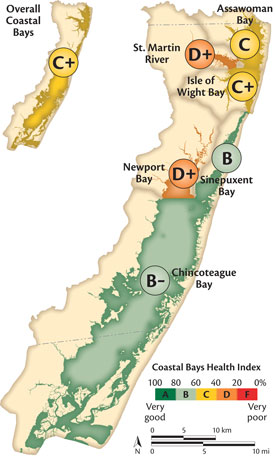Ocean City, Md. (June 8, 2009) – An independent scientific analysis developed by researchers from the University of Maryland Center for Environmental Science and the Maryland Coastal Bays Program gives the Maryland Coastal Bays a C-plus for ecosystem health in 2008. The study measured distinct differences in ecosystem health throughout the shallow bays behind Ocean City and Assateague, with southern regions such as Chincoteague Bay ranking higher than western tributaries such as the St. Martin River and Newport Bay.
 The Coastal Bays Report Card provides a scientifically robust – and geographically detailed –assessment of ecosystem health. The report card combines multiple indicators of water quality and habitat health into a single score for six regions of the Coastal Bays.
The Coastal Bays Report Card provides a scientifically robust – and geographically detailed –assessment of ecosystem health. The report card combines multiple indicators of water quality and habitat health into a single score for six regions of the Coastal Bays.
“The report card helps watershed residents easily compare the health of their local waters to other parts of the Coastal Bays,” said University of Maryland Center for Environmental Science researcher Dr. William Dennison. “This scientifically-detailed information is a new tool that both resource managers and environmental advocates can use to focus restoration efforts.”
While the overall health of the Coastal Bays in 2008 earned a C-plus, the health of the six reporting regions varied between locations, ranging from B to D-plus. Regional grades include:
- Sinepuxent Bay – B
- Chincoteague Bay – B-minus
- Isle of Wight Bay – C-plus
- Assawoman Bay – C
- Newport Bay – D-plus
- St. Martin River – D-plus
“One of the bright spots in this year’s report card is that the abundance of underwater seagrasses increased by 17% last year,” said Maryland Coastal Bays Program Executive Director David Wilson. “While this increase is a good sign that the downward trend observed in recent years may have stopped, it is still one of the lowest acreages seen in over a decade.”
The two mainland tributaries of St. Martin River and Newport Bay ranked the lowest of all regions, suggesting that the aquatic health of the Coastal Bays is strongly affected by nutrient loading from upland areas. Despite the moderate to good health scores in the other regions and an increase in seagrass area – which is likely due in part to lower than average rainfall in 2008 – recent increasing trends in nutrient concentrations indicate that development in the watershed poses a serious threat to the health of this ecosystem.
“By supporting the Coastal Bays report card, the Chesapeake Bay Trust hopes to create an active and engaged citizenry who better understand the health of their local waters and communities,” said Chesapeake Bay Trust Chief Scientist Dr. Jana Davis. “The scientific analysis behind this effort not only expands public understanding, it also provides a powerful targeting tool to watershed groups, citizens, and government groups working to protect and restore the Coastal Bays for future generations.”
The report card is produced by the University of Maryland Center for Environmental Science, EcoCheck (a NOAA-UMCES Partnership), and the Maryland Coastal Bays Program. Data and methods supporting this report card are collected and analyzed the Maryland Coastal Bays Program, University of Maryland Center for Environmental Science, National Oceanic and Atmospheric Administration, Maryland Department of Natural Resources, the National Park Service and Virginia Institute of Marine Science.
For more information about the 2008 Coastal Bays Health Report Card including region-specific data and downloadable graphics, visit www.eco-check.org/reportcard/mcb/2008.
The University of Maryland Center for Environmental Science is the University System of Maryland’s premier environmental research institution. UMCES researchers are helping improve our scientific understanding of Maryland, the region and the world through its three laboratories – Chesapeake Biological Laboratory in Solomons, Appalachian Laboratory in Frostburg, and Horn Point Laboratory in Cambridge – and the Maryland Sea Grant College in College Park.
# # #

